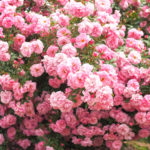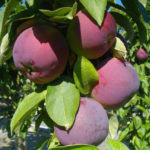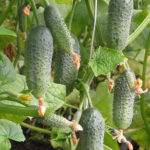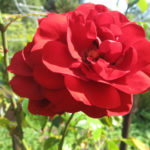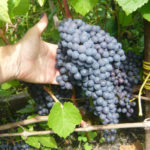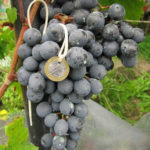Rose A shropshire lad
English roses for a flower garden are chosen, first of all, by refined, romantic natures, not devoid of love for the ancient past. The representative of this group of varietal plants, E Shropshire Led, will definitely become the favorite of such persons, because she has a magnificent color and attractive flower shape, and is also a hardy crop. All the details about this beauty are in this article.
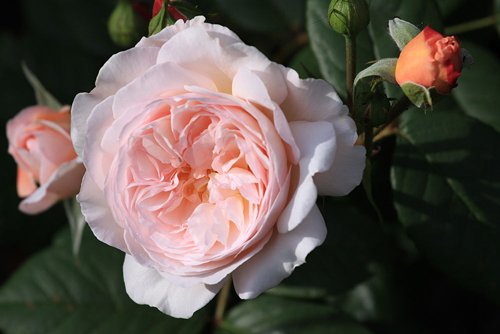
History of origin
An amazing variety appeared more than 20 years ago, in 1997. It was bred by the famous British breeder David Austin, using the Heritage variety as a basis. Our heroine was named after the eponymous poem cycle and poem "A Shropshire Lad", written at the end of the 19th century by the English poet Alfred Edward Houseman. The flower is the recipient of the Modern Shrub Rose award at the Fair Friends of the Rose Show. The species registration name is AUSled.
Description of appearance and features
The variety belongs to the group of climbing English roses. This is a vigorous, tall (from 1.5 to 1.8 meters) bush with arched drooping shoots, which can be easily put on any support. But even without it, it is quite possible to cultivate a plant, because a perennial in this case will have a rather neat appearance. The shoots of the culture of a burgundy shade are equipped with rare thorns and are covered with glossy, rich green foliage. It contrasts with large, up to 12 cm in diameter, incredibly delicate pink cupped flowers. I must say that in warm weather, in the inflorescences of the proud British beauty E Shropshire Led, there are more apricot notes. In the phase of complete dissolution, the outer petals of the buds bend to the bottom and show rich pink tones. On the edges of the petals, a pale cream color is observed.
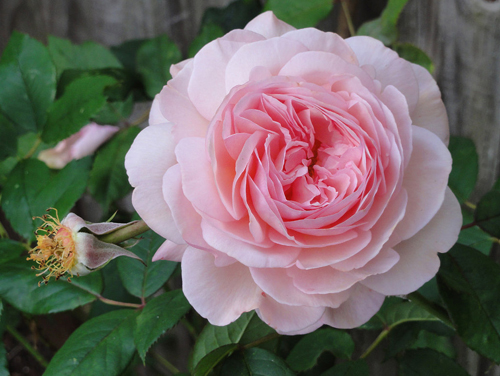
The flowers of this variety are very fragrant. Their scent combines the scent of tea hybrids and juicy fruits. The flowering of the culture takes place in two powerful waves and lasts from the end of June until the first autumn frosts. The flowers remain on the bush for quite a long time and keep their shape for a long time. They are collected in groups of 3-5 pieces each and are concentrated mainly in the upper part of the shoots.
The rose has a high growth rate and excellent immunity to fungal diseases, especially powdery mildew and black spot. The shrub is not very drought resistant, and its inflorescences are moderately resistant to rain. In the sun, the petals of amazing flowers do not bake or fade. The plant is winter-hardy, withstands frosts down to -29ºС.
Growing and care
Despite the rose's loyalty to unfavorable weather conditions, it is better not to plant A shropshire lad in a place where it will be influenced by direct sunlight all day long. If you neglect this recommendation, the flower petals of a delicate beauty will quickly crumble. The best option is to place the shrub in openwork penumbra. It should not be placed in a lowland due to stagnant moisture in such an area after heavy rains (in order to avoid decay of the roots).
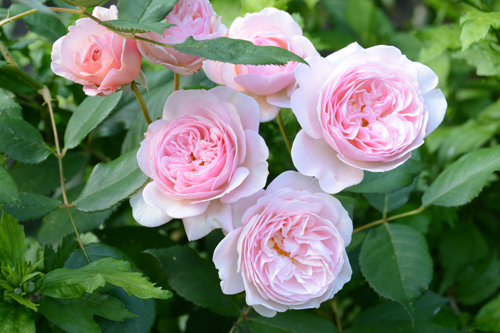
For planting E shropshire led, it is preferable to use fertile, loose soil with a neutral reaction. To increase the level of nutrient content of the soil, it is mixed with compost, humus and vermicompost, as well as a small amount of sand in order to increase the lightness of the substrate. It is required to plant a noble plant in a hole with a depth of at least half a meter and a similar width so that the buds are 3 cm below the soil level. Do not forget to lay an impressive layer of drainage material at the bottom of the hole. It is advisable to maintain a distance of 45-50 cm between plants. A denser planting will allow the culture to grow faster only over time. The very procedure for planting roses is carried out in the spring.
The British variety must be watered as the soil under the flower dries up, fertilized regularly, and pruned. Also, a decorative perennial will need loosening of the soil and weeding.It is necessary to water the culture only with warm, soft water, which is poured under the bush in the amount of 2-3 buckets. In hot weather, this is done up to three times a week. Top dressing of the bush is carried out in the standard way: nitrogen fertilization in the spring; mineral, including those containing trace elements - in the phase of bud formation, during the flowering period and a couple of weeks after the flowering of the rose. After loosening the soil, it will not be superfluous to mulch the soil under the bush in the zone of the trunk circle. They choose humus or dry grass for this. Pruning a varietal crop is needed in early spring. It consists in removing damaged shoots, dry stems and oversized branches from the bush. Crown thinning is also carried out in order to form it. In the summer, faded buds are removed without fail. In addition, the shoots are shortened by a third of their main length. This procedure helps to achieve the appearance of flowers along the entire length of the stems. When growing A shropshire lad in regions with harsh climates, it is best to cover the plant. A polycarbonate sheet is used as a heater. Previously, the perennial is covered with crushed pine bark at the base.
Use cases
The E Shropshire Led variety is used in landscape design for planting in rabatki, mixborders, and round flower beds. Rose bushes are planted on the site for the purpose of decorating a hedge, for decorating a gazebo, a low pergola, an arch, a house wall. The plant is also suitable for single plantings against the background of a bright grassy lawn or needles of evergreen plants in the background.
